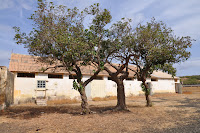Soon after our copious breakfast we decided to catch a public transport towards Tarrafal, so as to be able to visit the concentration camp and still have a bit of time to enjoy the beach. The weather seemed slightly better than the previous day and less windy as well.
The experience of having travelled inside a "Hiace" was quite an interesting one for my colleagues and their wives who had virtually no idea what it was all about ... the loud soon livened up the "clustered" atmosphere and at one point we were all clapping hands and singing the "sacudir poeira" (shake away the dust) funana, with João being utterly enthusiastic, which ultimately led a young passenger to film him with the mobile phone. On the way to Tarrafal there were 18 of us inside it though on the way back there were 22 of us ...
Rui, Wanda, Rosa and João (from left to right)
Despite not being so "impressive" as Auschwittz the visit to the concentration camp of Tarrafal, known as the "slow death camp" was very touching, taking into account the fact that it was and it will always be intimately connected to the sad history of our country and the memory of those who died there for politically opposing the Portuguese regime is still "visible" ... in the many posts dedicated to them.
I had visited it twice before (in 2001 and 2008) but found that the explanations to be seen in big boards (Mario Soares Foundation), provided a through explanation for those who know what it was like and certainly a very clear explanation to the young generation who might have vaguely heard about it.


Deportation (left). A violence founded regime (right).
Nazi-fascism resistance and uprising (left). The Concentration Camp of Tarrafal (right).
Silence and Censorship (left). Punishment and Forced Labour (right).
Death at the Concentration Camp (left). List of Portuguese political prisoners at the camp (right).

The "frigideira" (frying pan) isolation cell.
Although the concentration camp was built in 1936 to house 150 Portuguese anti-fascist prisoners and continued to house such prisoners until 1954, when it ended up being closed after International protests to later be re-opened in the 1960's to host the independence fighters from Cape Verde, Guinea Bissau and Angola.


The "frigideira" (frying pan) isolation cell.
Although the concentration camp was built in 1936 to house 150 Portuguese anti-fascist prisoners and continued to house such prisoners until 1954, when it ended up being closed after International protests to later be re-opened in the 1960's to host the independence fighters from Cape Verde, Guinea Bissau and Angola.

The Cape Verdian prisoners (left). Jaime Schoffield (left).
Amazingly enough amongst the Cape Verdian prisoners stood a familiar face, though whilst he was my student during an English Refresher course for ASA (Airports and Air Safety) in Sal I didn't realise he had been under such a situation. I must confess I was shocked, because despite the fact that throughout the course I felt he was a rather sad-looking character I had no idea what he had (must have) been through.
The prisoners from Guinea Bissau (left). The prisoners from Angola (right).
Life at the Camp (left). Solidarity (right).
Protest and Punishment (left). The surrounding sea as an ongoing illusion (right).
Habeas Corpus (left). The liberation - 1st of May 1974 (right).
Remembering the dead
































No comments:
Post a Comment